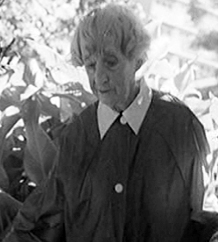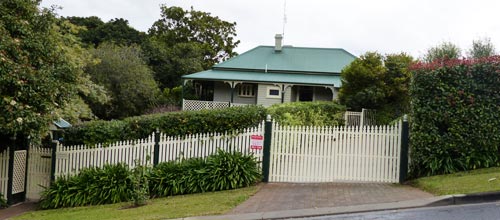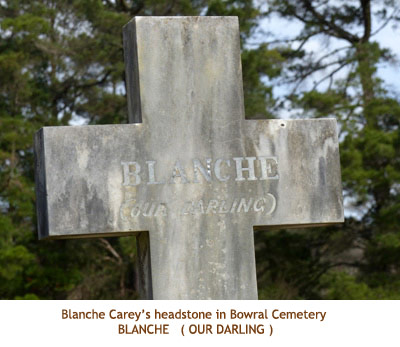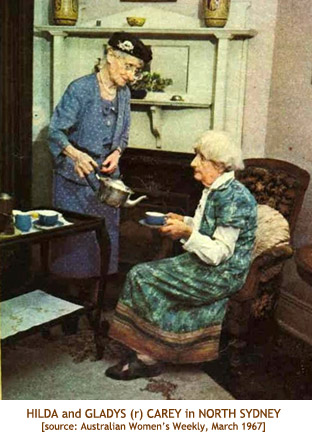My childhood at North Sydney took place in post-War Australia of the 1950s. Thankfully I still have many fond memories of not only the district but also the people I met there.
I lived with my family in Ulleswater, a large, rambling house that dates back to the nineteenth century. In the 1920s it was converted into flats. A significant landmark of a previous era, it overlooks Milson Park.
Milson Park was a very convenient place for me to play with my brother and our friends. It is a large, formally designed and attractive park. In my day, it had a good range of mostly sturdy, metal playground equipment. It was bordered on one side by an open, concrete, storm water channel which was too irresistible for us not to explore. The park is also part of the Sydney Harbour foreshore, meeting the waters of Careening Cove with a fenceless, stone sea wall. Despite the obvious dangers posed by this park from a twenty-first century disposition, parents appeared unperturbed. They seemed comfortable allowing their children to play in the park unsupervised. I spent a lot of time playing there, as did other children of the district. Hide and seek, cowboys and indians, soldiers, cricket, boats, chasings and the like were some of the childhood activities we played.
At the end of Bradley’s Avenue, which borders one side of Milson Park, there is another park. It nestles on an embankment above the avenue. This park is a much smaller one and its official name now is The Miss Gladys Carey Reserve. It can be accessed by either steps or a pathway from the avenue.
When I lived at North Sydney Miss Gladys Carey resided with her eldest sister Hilda in my street. I lived at 107 and they lived at 129 High Street.
Gladys Carey was born in London, England in 1881 to Edward and Fanny (nee Prebble) Carey. Her sister Hilda was the eldest sibling, born in Bologne, France in 1878.
The family sailed from the port of London to Australia as unassisted passengers on the steamship Sorata in November 1882, arriving in Sydney on 20 January1883. Along with her mother and sister Hilda who was four, she emigrated with an older brother Edward, age two and a younger sister Emily, age one. Gladys was one and a half years old when she arrived in Australia. The family were accompanied by Emily Holt, a twenty six year old who had been with the Carey family for at least two years as a cook and domestic servant. Mrs Fanny Carey’s younger sister, twenty two year old Blanche Prebble, also emigrated with the family.
The reason for their emigration to Australia is still a mystery to me. Surprisingly, and indeed sadly, there is no record of their father coming with them. Just what happened to him is another mystery.
Travelling with such very young children to the other side of the world appears a very courageous and determined act by this young twenty six year old mother. This seems even more so when we learn that Fanny Carey was pregnant when she left England and she had already given birth to Emily that same year. On 3 March, just over a month after their arrival, Mrs Carey gave birth to another daughter whom she named Blanche. The birth was at the family’s residence in Falcon Street, then included in the suburb of St Leonards NSW. They lived there at least until 1886.
In May 1888, the centenary year of European settlement in Australia, Mrs Carey sought tenders on the excavation and removal of earth and stone on land in the Southern Highland township of Bowral. The family moved into their new weather board home in Oxley Street, on the foothill of Mount Gibraltar, later that year. Mrs Carey named the home Norwood, apparently after the old London parish name from where her husband came.
The children attended the Superior Public School in Bowral. The large grounds surrounding their home and the close proximity to Mt Gibraltar would have provided the children with plenty of places to explore and play. Gladys’s obvious love, shown throughout her life, for the outdoors and the natural world was more than likely to have been nurtured there.
Mrs Carey’s sister Blanche also moved with the family to Bowral and with Fanny became ‘leading residents of the district’.
In 1895 the youngest child Blanche sadly died of pneumonia. The only family member born in Australia, she was just twelve years old. Only a week before her death, the family had celebrated the news of Hilda’s academic achievements at Willandra in Ryde, where Miss Ellen Pye conducted Rydalmount, a private boarding and day school for girls.
Both Gladys and Hilda Carey had careers in the teaching profession. Gladys graduated from the Free Kindergarten Training College in Sydney. In October 1901 she was placed in charge of the new Free Kindergarten School in Bowral. This was the first Free Kindergarten school established outside Sydney. When a new schoolroom was built in 1902 Gladys’ “pretty flower-bedecked room, and clever drawings displayed on tho walls” were admired by those who attended the opening.
When their brother Edward married Amy Caunt at St James Church, Sydney in April 1904, he was described as the only son of the late Edward Carey, England. This is the first documented reference to their father being deceased that I have so far discovered. When and where he died is still a mystery. Their sister Emily married Arthur John Debenham in Sydney in May 1910.
At the beginning of March 1917, Mrs Carey’s household furniture and effects were auctioned at Norwood. Gladys and her mother left Bowral and moved to the Blue Mountains. Gladys’ teaching career was cut short so that she could care full time for her mother. They lived at Arlington, in Walgett Street, Katoomba. The rear of the Carrington Hotel with its large chimney can be clearly seen from the home. High on a ridge, they had expansive, mountain views. Whether the move to the Blue Mountains was made in the interest of Mrs Carey’s health is unclear. They resided at Katoomba until August 1937 when Fanny Mary Carey died. By then Gladys had been looking after her mother for 19 years.
During her life, Fanny Carey gave generously to a variety of causes, including the Belgium Relief Fund in 1915, the Second Peace Loan in 1920 where she subscribed a thousand pounds, as well as many other local causes.
While caring for her mother at their Katoomba residence, Gladys made a garden on a steep, neighbouring embankment. In 1936 her efforts caught the attention of the local council. The mayoral minute of Alderman Soper was quoted as follows in the Katoomba Daily:
‘It is with pleasure that I have to report that Miss Carey, of Walgett Street, has exhibited a particularly fine civic spirit in constructing a rockery and gardens at the end of Walgett Street, where it leads to the lower road level. The work has been well done and is a credit to Miss Carey’s industry and enthusiasm. I recommend that a letter be addressed to Miss Carey conveying this Council’s sincere thanks and appreciation for the improvements effected by her in beautifying this area.’
On 24 September of the following year, a month after her mother’s death, another reference to the garden, under the heading A Labour of Love, again appeared in the Katoomba Daily. It was contributed to the newspaper by an appreciative resident and read as follows:
‘As I was taking a quiet walk along Walgett Street, Katoomba, the other day, I came upon an embankment of various plants of shrubs of every conceivable name, from the pretty little Forget-Me-Not upwards, interspersed with wild ferns from the bush, and divided by walks between the numerous bordered ironstone beds. I was told on making enquiries that the landscape gardener of this magnificent piece of beauty was a lady living on the brow of the hill by the name of’ Miss Carey. It is a veritable feast for the eyesight to gaze on an embankment turned into a beauty spot by an indefatigable effort on the part of a lady in her spare time, for which she is deserving of the highest praise by the residents and visitors alike of the Blue Mountains.’
After her mother’s death, Gladys moved to 129 High Street to live. Hilda had already been living there since 1931. Gladys later purchased the property and the two sisters resided there for the rest of their lives.
It was during the Second World War that The Miss Gladys Carey Reserve was born. The war had resulted in a shortage of labour in many local communities. People living in North Sydney were asked by their local council to look after the appearance of their part of the street. Miss Carey acted upon this request, keeping not only the footpath in front of her home tidy, but other neighbours’ home fronts as well. Close to Miss Carey’s house was a walkway down to Milson Park. Most of this walkway was a steep staircase which passed by an area of land that had been left to run wild. As in Katoomba, another opportunity to beautify an overgrown, unloved area of land presented itself to Gladys Carey. Over the next twenty years she changed this over grown space into a small, attractive park.
When I first met Miss Gladys Carey in the 1950s she was in her mid to late seventies. I can still remember her quite clearly. Her pale, tissue paper skin was creased by her life of care and usefulness. A kindly sparkle in her eyes shone from under a mop of white hair.
I remember her always in a long dress when working in the park. Bad weather never stopped her gardening and she could be seen toiling away on the most miserable of days. All the plants she grew came from cuttings from her own garden, her neighbours’ and even those which people had discarded. The stones that formed the rockeries were all manoeuvred into place by her.
During my early childhood, bread was delivered to homes in our district by horse and cart. The baker’s cart would stop each day opposite Ulleswater. At my mother’s suggestion, I would shovel up the horse manure that was deposited most days on the road after the baker’s delivery. With my bucket of hot manure, I would then walk the short distance to Miss Carey’s park and leave the contents there. She was a very friendly lady and always thankful for the gift. I remember once, after she had tended her gardens and rockeries, that she went home and returned with some slides and a viewer. Seating herself in Milson Park, she proceeded to show my friends and me slides of far away places from around the world. There is a newspaper reference to her sister Hilda having travelled to Greece after the Second World War . I wonder if Gladys accompanied her and that the slides she showed us that day were of some of the countries the sisters visited.
Early in 1967 the local council recognised the work of Miss Carey by naming the park The Miss Gladys Carey Reserve. The Australian Women’s Weekly on 1 March that year included a feature story with the heading The Park Miss Gladys Made. It included some large, coloured photographs of Miss Carey, her park and the new wooden sign bearing her name. That same year she was also featured in a Cinesound Review newsreel about the park. She was described as ‘a remarkable lady with a sense of civic pride’.
On Australia Day 26 January 1972 Miss Gladys Carey died at the Neutral Bay Convalescent Hospital, after a short stay there. She was 90 years old. Her sister Hilda had died in March the previous year.
In 1989 I composed a song which I called Miss Carey’s Little Park. It was a way of documenting a significant childhood memory. Over the years I have performed the song many times and have had people tell me that they visited the park after hearing my song. Earlier this year I recorded the song with Chloe and Jason Roweth. It was my way of again celebrating Miss Carey’s life, especially since 2017 is the fiftieth anniversary of the naming of the park.
I still return to North Sydney and stroll its streets. Whenever I do so, I try to make time to visit Miss Carey’s Park. It is there I happily spend time reflecting on this unassuming lady who believed in the value of living a useful life.
© Jim Low
Music:
Listen to the song, Miss Carey’s Little Park
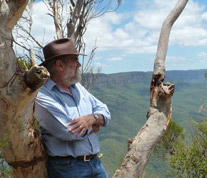
Jim Low is a singer/songwriter and published author. His background is in education and he has also developed learning materials for the NSW Department of School Education. His passion is Australian history.
EMAIL: jim@jimlow.net WEBSITE: jimlow.net

